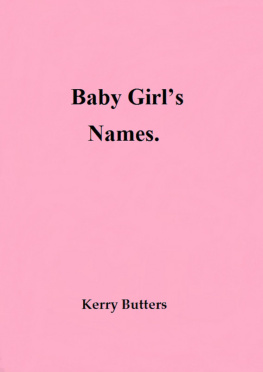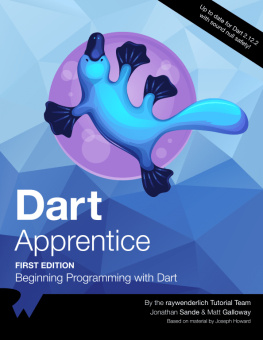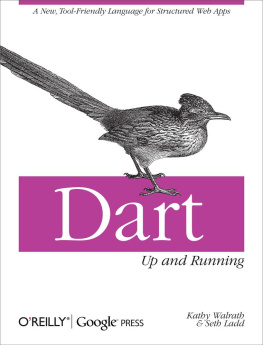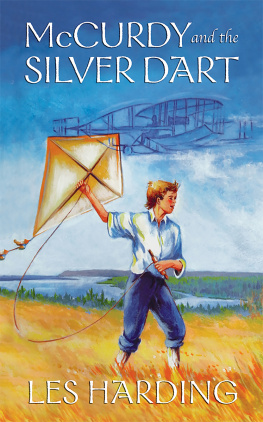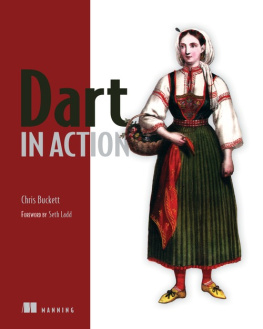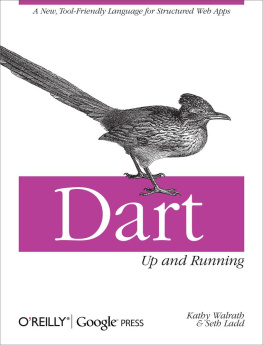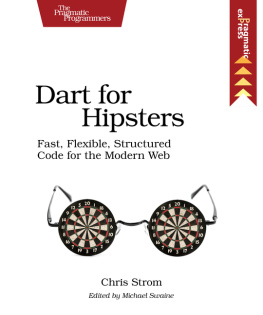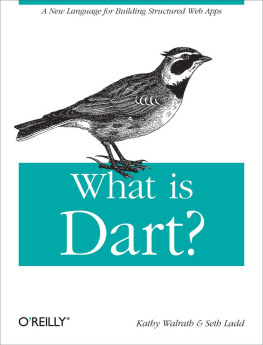Kerry Butters - 40 Easy Dart Games.
Here you can read online Kerry Butters - 40 Easy Dart Games. full text of the book (entire story) in english for free. Download pdf and epub, get meaning, cover and reviews about this ebook. year: 2017, publisher: Kerry Butters, genre: Children. Description of the work, (preface) as well as reviews are available. Best literature library LitArk.com created for fans of good reading and offers a wide selection of genres:
Romance novel
Science fiction
Adventure
Detective
Science
History
Home and family
Prose
Art
Politics
Computer
Non-fiction
Religion
Business
Children
Humor
Choose a favorite category and find really read worthwhile books. Enjoy immersion in the world of imagination, feel the emotions of the characters or learn something new for yourself, make an fascinating discovery.
- Book:40 Easy Dart Games.
- Author:
- Publisher:Kerry Butters
- Genre:
- Year:2017
- Rating:3 / 5
- Favourites:Add to favourites
- Your mark:
- 60
- 1
- 2
- 3
- 4
- 5
40 Easy Dart Games.: summary, description and annotation
We offer to read an annotation, description, summary or preface (depends on what the author of the book "40 Easy Dart Games." wrote himself). If you haven't found the necessary information about the book — write in the comments, we will try to find it.
40 Easy Dart Games. — read online for free the complete book (whole text) full work
Below is the text of the book, divided by pages. System saving the place of the last page read, allows you to conveniently read the book "40 Easy Dart Games." online for free, without having to search again every time where you left off. Put a bookmark, and you can go to the page where you finished reading at any time.
Font size:
Interval:
Bookmark:
Copyright 2017 KerryButters
Published by KerryButters at Smashwords
Smashwords EditionLicense Notes
This ebook is licensedfor your personal enjoyment only. This ebook may not be re-sold orgiven away to other people. If you would like to share this bookwith another person, please purchase an additional copy for eachrecipient. If youre reading this book and did not purchase it, orit was not purchased for your enjoyment only, then please return toSmashwords.com or your favorite retailer and purchase your owncopy. Thank you for respecting the hard work of this author.
Contents
1 Rules For Cricket
Cricket:
Cricket is afavorite dart game and also the one that I learned first. It isalso the most common one played in bars across the U.K and America.Cricket is a game that, unlike x01, requires some strategy that canhelp a weaker player beat a stronger player.
The Object:The object of the game is to "close" all your numbers (20 downthrough 15 and bulls-eye) and end up with more or equal points toyour opponent. To close a number, you must hit three of thatnumber.
The Scoring:The scoreboard is drawn with the numbers 20 through 15 and bullseyewritten in descending order down the center of the board. Bullseyeis usually abbreviated with a B (or C for cork, another term forthe bullseye). Each dart that lands in any of the games numberscount toward closing that number. The thin outer ring counts as twoof that number and is called a "double". The thin inner ring countsas three of that number and is called a triple. Scoring for onedart is shown by placing a slash ( \ ) next to the number scored.Scoring for two is shown by placing an X next to the number scored.Scoring for three is shown by placing a circle next to the numberto indicate it is closed. When three of a number is scored in anycombination, it is closed.
The Play: Theplayers each take a turn throwing one dart at bulls-eye, closestdart to the bull's-eye gets to throw first. The first player throwsthree darts at any of the scoring numbers to try to close thatnumber and/or score points (points will be explained later, andgames can be played without points). The player then scores thedarts that he has thrown and play alternates until one personcloses all their numbers and has more or equal points to theopponent.
Now let's talkabout points. Points is what makes the game of Cricket veryinteresting. After you close a number, if your opponent does nothave the same number closed, any darts that land in that numbercount as points for you and are totaled on your side of the board.For example, you have your 18 closed and your opponent only has one18. If you throw a triple 18, you now have 54 points added to anypoints you may have already scored. If your opponent now throws atriple 18, only two count to close the number. The third does notcount for points because your 18 is already closed. If a player hasall of their numbers closed including bull's-eyes but has lesspoints, that player has not yet won the game. He must throw enoughpoints to be even or ahead of the opponent. If the only number theopponent has open is bull's-eyes, then the player must throw extrabull's-eyes at 25 points each (or 50 points for the doublebulls-eye).
Strategy: Thebest strategy is to close the highest numbers first in descendingorder (this is the reason they are written that way on thescoreboard). The reason for this is that if points are scored, theplayer with the higher number closed has a big advantage. If youclosed your 20 and scored 20 points in your first round, youropponent would have to throw TWO 19's after they are closed to makeup the points and score 38.
One importantnote that I should point out (no pun intended): Deliberatelyshooting too many points can lead to a bar-room brawl. Darts isconsidered a "polite game" much like golf. Players do not typically"point monger" each other. Staying one or two bull's-eyes ahead (25to 50 points) is acceptable. Throwing more points on another playerthat is not an INCREDIBLY stronger player is not a good idea.
On the otherhand, by scoring an appropriate number early and simply staying ontop of the other player, a weaker player can often beat a strongerplayer by making the other player have to throw extra bull's-eyesto end the game. Be very careful with this strategy though,sometimes the other player might suddenly turn the tables and willbe sure to remember all those extra points you threw on him!Another thing that can happen is that you waste time trying to besure you have enough points and when you get to the bull's-eyes,you discover that the other player couldn't miss a bull if hetried. What you wind up with is alot of darts you wasted that couldhave been tried at bulls and an opponent who is grinning from earto ear. A clue to warn you that this is happening is when you throwalot of points and your opponent doesn't seem to care (that is he'snot throwing any points back).
2 Rules For x01
x01:
x01(pronounced oh-one) is probably the easiest game to learn. Therules are very simple, yet the game requires skill in order to playwell and win. It is a very good game for beginners because itdevelops accuracy around the whole board and the simple rules allowthe players to concentrate on their throwing.
The Object:The game play starts with a score of 301, 401, 501, 601 or 1001.The object is to get to exactly zero by throwing rounds of threedarts and subtracting the sum of those darts from your currentscore. Games may be played as "double-start" (also called"double-in") or "straight start" (also called "straight-in") thiswill be explained in THE PLAY section of this page. Games may alsobe played as "double out" ("double finish") or "straight out"("straight finish") however "straight out" is extremely rare. Gamesof 301 and 601 are typically played as double in/double out. Whilegames of 401, 501 and 1001 are typically played as straightin/double out.
The Scoring:The agreed upon starting score of the game is written at the topcenter of the score board (ie: 301) with a vertical line drawn downthe center of score board. "DD" or "SD" are written above or belowthe starting score to indicate the agreed upon game(double-in/double-out or straight-in double-out). After each round,the total points thrown is written on the board along with theremaining score on that player/team's side of the board. A score of100 is called a "ton" and is written on the board as a "T". Scoresover 100 are called "ton" plus the rest that was thrown. Forexample a score of 120 would be called "a ton twenty" and would bewritten on the board "2T0".
The Play: Bothplayers (or one player from each team) throw one dart each at thebulls-eye. The closest to the bulls-eye gets to throw first.Typically this player also names the game to be played. Theinitials of the players are written above each column of thescoreboard with the winner of the bulls-eye on the left.
If the gamewas called as a straight-in game, the first player (winner of thebulls-eye) begins by throwing three darts trying to attain thehighest score possible. Each dart is scored by the number where itlands with the thin inner ring being worth 3 times the numberindicated and the thin outer ring worth 2 times the numberindicated while the two large sections score exactly the numberindicated. Thus the highest attainable score with three darts is180 by hitting three triple 20's.
If the gamewas called as a double-in game, the first player must hit anydouble on the board before they may begin counting their score. Forexample if the player threw a single 20, a double 20 and a single20 the score would be 60 points. The first dart did not countbecause the player had not yet hit a double so only the second andthird darts did count. Once a player has "gotten in" subsequentrounds do not require a double be thrown again.
Play continuesalternating the players on each side of the board. When the scoresget low the player starts to need to think about how they are goingto get "out". The exact number a player should start to think aboutthis varies with ability. A beginner should try to get to 40 or 32(see the STRATEGY section) while an expert will start looking at160!
Font size:
Interval:
Bookmark:
Similar books «40 Easy Dart Games.»
Look at similar books to 40 Easy Dart Games.. We have selected literature similar in name and meaning in the hope of providing readers with more options to find new, interesting, not yet read works.
Discussion, reviews of the book 40 Easy Dart Games. and just readers' own opinions. Leave your comments, write what you think about the work, its meaning or the main characters. Specify what exactly you liked and what you didn't like, and why you think so.



